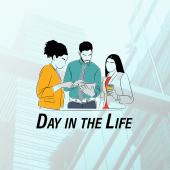Here’s a fun game to play in a crowded place: Stop in the middle of an open location, then just look up and stare.
Invariably, passing strangers will want to know what has caught your attention. A few will only slow their stride and glance in the same direction. Others, however, will stand beside you, follow your line of sight and concentrate intently, without even saying a word.
Soon, a small crowd will form, staring at nothing.
Many of us know this is true from personal experience. If I notice someone looking intently at a particular spot, I will also look in that direction. I blame it on basic curiosity, but it feels instinctive.
And it is instinctive. Studies conducted by evolutionary biologists prove that we naturally follow this pattern. In carefully monitored experiments, researchers have placed subjects in the middle of a train station or shopping thoroughfare and asked them to just look at a particular location in the distance. As expected, others stop and stare. While the reaction varies by setting, distance and sometimes gender, human beings have a natural tendency to follow the gaze of others.
This reaction may be a fundamental part of our evolutionary wiring, and for good reason. Forty thousand years ago, our survival on a hostile savanna depended on seeing and reacting to external stimuli. We were more likely to survive if we quickly saw what others saw. If a fellow human noticed something interesting, then it was probably worth knowing about, no questions asked.
Today, we see this response in all types of crowds: parties, concerts, public spaces, everywhere people gather. And it can quickly extend to other behaviors. In a crowd that shares a common stimulus, such as a sporting event or demonstration, groups of individuals act in unison. We sense the stimulus collectively and react simultaneously. There are no instructions, only natural collective action.
But sometimes, some members of the crowd should be looking elsewhere. US Secret Service agents purposefully look in every direction, intentionally away from the focus of activity. In sports, referees are trained to watch the entire field, not just the ball. As long as there have been armies, there have been guards posted at the rear, watching for a sneak attack.
And for companies, in-house lawyers are also expected to see the unexpected. If everyone in the company is looking one way, the lawyers have to look everywhere else.
Not following the crowd is hard to do. But it is what our company and colleagues expect. We are paid to see unforeseen problems and anticipate them.
This responsibility, however, is especially difficult when you are one of the leaders in the crowd. As the legal team member working on a project, once your attention falls on a problem, the entire group will focus on that problem. You are not just a stranger on a train platform, looking up. You are a recognized and respected guide. Everyone will follow your gaze.
It may be difficult to not follow the crowd, but sometimes it is even harder to prevent the crowd from following you.
But that is exactly what good in-house lawyers have to do. On a multifunctional team, we work toward a collective goal and raise any serious issues that stand in the way. And at the same time, we have to be wary of unforeseen and unlikely problems. We must contemplate and anticipate what others don’t, without distracting our coworkers with distant risks.
This careful balance between vigilance and pragmatism is the duty of in-house lawyers everywhere. You have probably experienced a situation when that balance was lost: an attorney who is unintentionally alarmist, constantly raising miniscule risk, sending the team and the company into a worried frenzy.
In contrast, the wise in-house lawyer recognizes that her words have real effect. She knows that her passing remarks, however petty, become other’s nightmares. She draws the group’s attention to real problems while keeping a quiet, careful eye on every other issue.
Because everyone wants to know what she is staring at.




